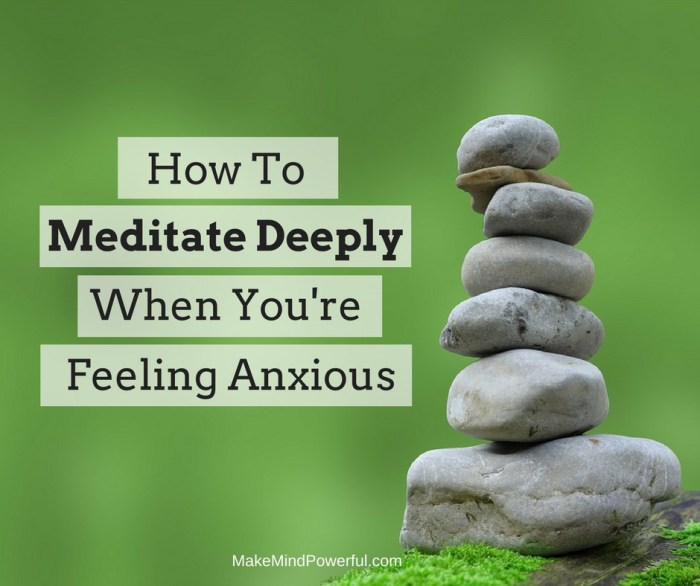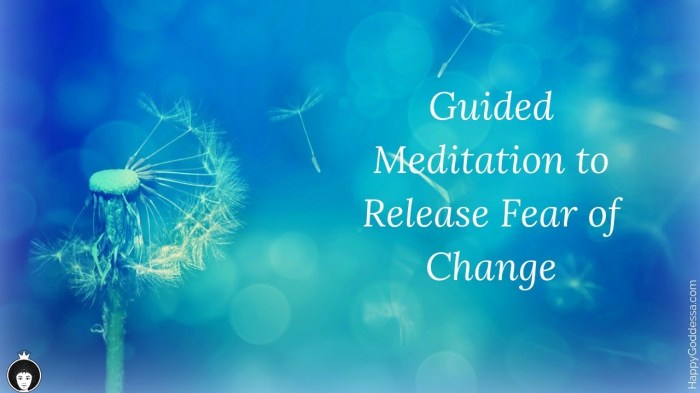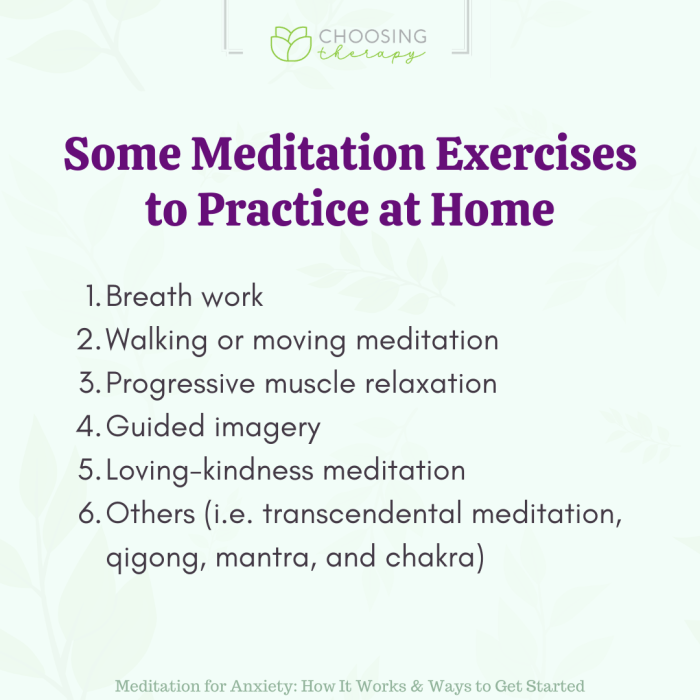How to Meditate for Releasing Fear and Negative Emotions sets the stage for a transformative journey into the realms of mindfulness and emotional liberation. As we delve into the intricacies of meditation, fear, and negative emotions, a tapestry of self-discovery unfolds, offering solace and clarity amidst life’s chaos.
This guide is a beacon of light, illuminating the path towards inner harmony and resilience, guiding readers through the labyrinth of their emotions with grace and wisdom.
Introduction to Meditation for Releasing Fear and Negative Emotions

Meditation is a practice that involves training the mind to focus and redirect thoughts. It has numerous benefits for mental and emotional well-being. By incorporating meditation into daily routines, individuals can experience reduced stress, increased self-awareness, and improved concentration.
Inner strength and balance are essential for living a fulfilling life, and meditation is a powerful practice that can help us achieve this state of being. By connecting with our inner selves and cultivating self-awareness, we can tap into a limitless source of strength and resilience. Dive into the practices shared in How to Meditate for Achieving Inner Strength and Balance to nurture your mind, body, and spirit.
Benefits of Meditation
- Meditation helps in calming the mind and reducing anxiety.
- It can aid in processing and releasing negative emotions like fear, anger, and sadness.
- Regular meditation practice can improve emotional resilience and enhance overall mental health.
Releasing Fear and Negative Emotions through Meditation
- During meditation, individuals can observe their thoughts and emotions without judgment, allowing them to acknowledge and let go of fear and negativity.
- By cultivating a sense of inner peace and mindfulness through meditation, individuals can develop the ability to respond to challenging situations with clarity and calmness.
- Meditation techniques such as loving-kindness meditation can help in promoting feelings of compassion and positivity, reducing the impact of fear and negative emotions.
Importance of Incorporating Meditation into Daily Routines
- Consistent meditation practice can create a sense of balance and emotional stability in daily life.
- By setting aside dedicated time for meditation each day, individuals can prioritize their mental health and well-being.
- Regular meditation can lead to increased self-awareness, emotional regulation, and a deeper sense of inner peace.
Understanding Fear and Negative Emotions

Fear and negative emotions are common experiences that can have a significant impact on our mental well-being. These emotions can manifest in various ways in our daily lives, affecting how we think, feel, and behave.
Life’s challenges can often leave us feeling lost and confused, but through meditation, we can find the clarity we need to navigate through difficult times. By quieting the mind and tuning into our inner wisdom, we can gain a fresh perspective and discover solutions to our problems. Explore the techniques outlined in How to Meditate for Finding Clarity in Life’s Challenges to experience a sense of calm and direction.
Types of Fears and Negative Emotions
- Fear of failure: This fear can hold us back from taking risks or pursuing our goals.
- Anxiety: Constant worry and unease can lead to feelings of anxiety that can be overwhelming.
- Anger: Feeling angry or frustrated can negatively impact our relationships and overall well-being.
- Jealousy: Comparing ourselves to others can result in feelings of jealousy and inadequacy.
Impact of Fear and Negative Emotions on Mental Well-being
- Decreased self-esteem: Fear and negative emotions can lower our self-esteem and confidence.
- Increased stress: Constantly experiencing these emotions can lead to chronic stress and its associated health issues.
- Isolation: Fear and negative emotions can cause us to withdraw from social interactions, leading to feelings of loneliness.
Examples of Manifestations in Daily Life
- Procrastination: Fear of failure can result in procrastination and avoidance of tasks.
- Overreacting: Negative emotions like anger can cause us to overreact to situations that may not warrant such a strong response.
- Rumination: Anxiety can lead to excessive rumination, where we constantly dwell on negative thoughts and scenarios.
Techniques for Meditating to Release Fear and Negative Emotions

When it comes to managing fear and negative emotions through meditation, there are several effective techniques that can help you find inner peace and calm your mind.
When it comes to overcoming negative thought patterns, meditation can be a powerful tool to reprogram the mind. By practicing mindfulness and focusing on the present moment, we can learn to let go of destructive thoughts and cultivate a more positive mindset. Check out this guide on How to Meditate for Overcoming Negative Thought Patterns to start your journey towards inner peace.
Mindfulness Meditation
- Focus on the present moment without judgment
- Acknowledge your feelings and thoughts without getting attached to them
- Observe your breath, bodily sensations, and surroundings
- Practice self-compassion and kindness towards yourself
Visualization Techniques
- Imagine releasing your fears and negative emotions as dark clouds drifting away
- Visualize yourself surrounded by a protective light or energy that shields you from negativity
- Create a mental image of a peaceful place where you feel safe and secure
- Picture yourself letting go of your fears and embracing positivity and calmness
Breathing Exercises
- Practice deep breathing by inhaling slowly through your nose and exhaling through your mouth
- Focus on the rhythm of your breath to anchor yourself in the present moment
- Try counting your breaths or repeating a calming mantra to enhance relaxation
- Engage in diaphragmatic breathing to activate the body’s relaxation response
Creating a Meditation Routine: How To Meditate For Releasing Fear And Negative Emotions

Establishing a consistent meditation practice is key to reaping the benefits of releasing fear and negative emotions. Here are some tips to help you stay on track:
Setting a Schedule, How to Meditate for Releasing Fear and Negative Emotions
- Choose a specific time each day for meditation, whether it’s in the morning before starting your day or in the evening before bed.
- Consistency is key, so try to meditate at the same time every day to form a habit.
Creating a Sacred Space
- Find a quiet and comfortable place where you won’t be disturbed during your meditation practice.
- Decorate your meditation space with calming elements like candles, cushions, or plants to enhance the experience.
Incorporating Meditation into a Busy Schedule
- Start with short meditation sessions, even just 5-10 minutes a day, to make it more manageable.
- Use breaks during your day, such as lunchtime or between tasks, to sneak in quick meditation sessions.
- Consider meditating during your commute or before going to bed if finding time during the day is a challenge.
Combining Meditation with Other Practices for Emotional Release

Combining meditation with other practices can enhance emotional well-being by providing a holistic approach to releasing fear and negative emotions. By incorporating yoga, journaling, and gratitude practices into your meditation routine, you can amplify the benefits and achieve a deeper sense of emotional release.
Benefits of Combining Meditation with Yoga for Emotional Well-being
Yoga and meditation complement each other perfectly, as they both focus on connecting the mind, body, and spirit. Yoga postures help release physical tension and promote relaxation, while meditation cultivates mental clarity and emotional balance. By combining the two practices, you can experience a synergistic effect that calms the mind, reduces stress, and promotes overall emotional well-being.
Role of Journaling in Conjunction with Meditation for Processing Emotions
Journaling can be a powerful tool when used in conjunction with meditation for processing emotions. Writing down your thoughts and feelings before or after meditation can help you gain insight into your inner world, identify patterns, and release pent-up emotions. Journaling allows you to express yourself freely, without judgment, and serves as a therapeutic outlet for processing and releasing fear and negative emotions.
How Gratitude Practices Enhance the Effects of Meditation in Releasing Fear and Negative Emotions
Practicing gratitude alongside meditation can deepen your emotional release by shifting your focus from fear and negativity to positivity and abundance. By expressing gratitude for the present moment, your experiences, and the people in your life, you cultivate a sense of appreciation and contentment. This positive mindset can help you let go of fear and negative emotions, fostering a greater sense of peace and emotional well-being.
In the symphony of life, where fear and negativity often play discordant tunes, the melody of meditation emerges as a soothing balm, harmonizing the soul and restoring balance. Embrace the transformative power of meditation as you embark on a journey of self-healing and emotional liberation.